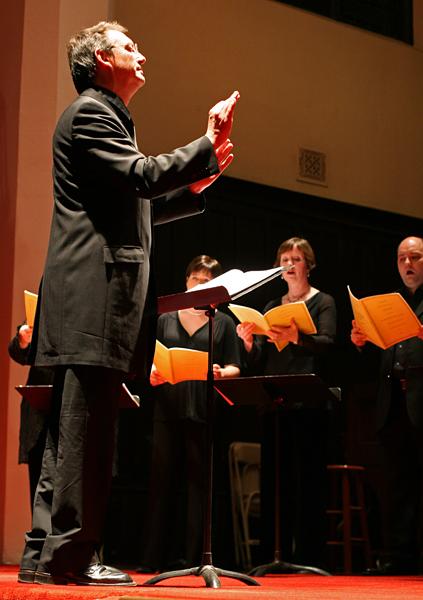
The nine pieces performed by the Scholars and composed by a smorgasbord of 16th century artists come from a unique juncture between two points of musical development, Rennaisance and Baroque. The program notes were dense with descriptions of the pieces’ musical subtleties and influences on future developments in “secular, opera and instrumental music” in their role as “proto-Baroque experiments.”
Phillips acknowledged the difficulty many audience members might have interpreting the music, calling two pieces “extremely complex mathematically” in a break between songs during the middle of the concert. While describing the echoing, overlapping and inverting interactions between the disparate groups within the choir, he noted that “you won’t hear this—nobody can. But that’s how the pieces are written.”
The atmosphere was relaxed, and the audience seemed able to enjoy the music without an encyclopedic knowledge of 16th century choral music. The pieces encompassed a wide spectrum between soft and loud, slow and quick. The presence of a male alto added a uniqueness to the event beyond its inherent remarkableness.
The highlights of the show included the pieces “Ave Maria” and “Nesciens Mater” by Alonso Lobo and Jean Mouton, respectively, the most musically unique of the pieces due to their aforementioned complexity. The audience enjoyed “Missa Bell’ Amfitrit’ alterat”, a parallel of Catholic mass, to the point that they applauded between each movement, visibly surprising the Scholars.
Still, to the untrained ear, the differences could be hard to distinguish and the music could seem mundane. An elementary school-aged boy was allowed access to his PSP after the third song, and spent the rest of the concert watching YouTube videos. Another student, looking conspicuously drowsy, rested his head several times on the pew in front of him. It was a concert to calm attendees and allow them to think, not necessarily to awaken and excite.
I went into Herrick something of a choral virgin—I have enjoyed the Tallis Scholars via Pandora and CDs checked out from Burling over the past year, while also attending nearly all of the Grinnell Singers concerts. But the sonic elegance displayed by some of the finest vocalists in the world was overwhelmingly beautiful and mesmerizingly balanced, with or without extensive knowledge of the music being performed.
As the last performance of the Grinnell College Public Events Committee this year, the Tallis Scholars proved a noteworthy and solidifying end to a program that has included the likes of Wynton Marsalis and Inti-Illimani. Marsalis brought us the lights of the city and Inti-Illimani the sounds of Chilean folk music, but the Scholars showed us the sweeping grandeur some modern of music’s origins.




























































